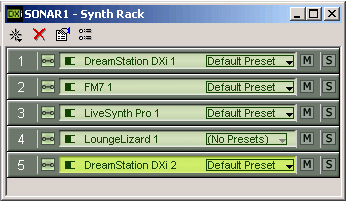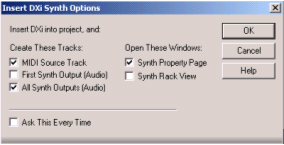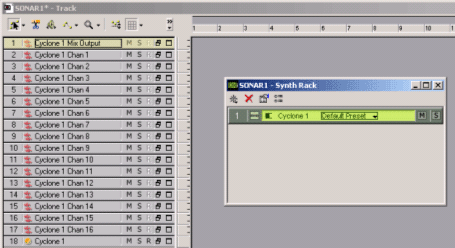Using SONAR 2.x & Home Studio 2004's DXi Enhancements
Last updated on 3/31/2016By Jesse Recinos, Cakewalk
There are a number of DXi enhancements in SONAR 2.x and Home Studio 2004. Two of the biggest improvements are the Synth Rack and automation from the synth interface. Read the tech tip below to learn how to take advantage of these features.
SONAR 2.x and Home Studio 2004's new Synth Rack
SONAR has always been about enhanced workflow without sacrificing power. With the new Synth Rack view, you can easily insert instruments or ReWire devices into your project. SONAR and Home Studio will automatically create the host Audio and MIDI tracks for the instrument, assign the proper inputs/outputs, and link the Mute/Solo functions together.

SONAR 2.0's Synth Rack View
Now it's easy to view all of your DXi synthesizers at a glance along with their current presets. In addition, the Synth Rack gives you access to the advanced features of DXi 2 such as multiple outputs.

By clicking on the Options button you can configure the way that your DXi and ReWire devices are displayed and set up.

Synths written to the DXi 2 format and ReWire devices such as Cyclone and Reason can send information into SONAR and Home Studio using multiple outputs/tracks so that you can process different samples and instruments with different effects, all from one plug-in. With support for up to 64 individual outputs for a ReWire device, there's almost no limit to the depth of your production.

One instance of Cyclone using 16 individual outputs
Even with the exceptional optimization found in the DXi format, you can still sometimes get carried away with the number of synths and effects you try to use, which might push your CPU to the limit. Simply bounce down some synth tracks, then Bypass the DXi from the Synth Rack to reduce CPU overhead in your project. The Disconnect button in the Synth rack will turn red to remind you that the synth is offline.
Automating
using the synth interface
Another great new feature in SONAR 2.x and Home Studio 2004 is the ability to automate DXi parameters on the fly from the synth's UI (user interface). Twist a knob in real-time and SONAR and Home Studio will record and play back all of your tweaks. Lets take a look at how easy it is using the DreamStation 2.0 DXi found in SONAR 2.0 and Home Studio 2004.
First, we’ll add DreamStation to our project by using the Synth Rack. Once the MIDI and Audio tracks have been added, record or copy and paste some MIDI data. In this instance I’ve copied in a funky bass line with a Synth Bass preset.

DreamStation will send out its controller data as MIDI, so you can record this automation to your existing MIDI Track. First, make sure to set the following options:
• In Options | Global | MIDI make sure that Echo DXi Input to All MIDI Tracks is checked.
• Transport | Record Options | Recording Mode should be set to Sound on Sound (Blend).
Now arm your MIDI Track, press Record and start adjusting the parameters. In this case I’m going to raise the Resonance and then lower the Cutoff for a classic analog filter sweep. When you’re done, you should see something resembling the following:

You’ll notice the automation recorded on the same track as the MIDI data. Of course, if you’d like to keep the automation and MIDI notes separate, you can record the automation to a different MIDI track instead. You can repeat this multiple times, recording a different parameter every time.
These are just a few of the really cool things that SONAR 2.x and Home Studio 2004 bring to the table.